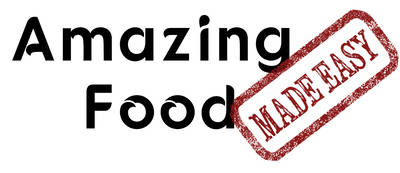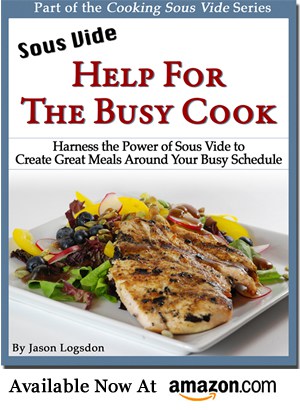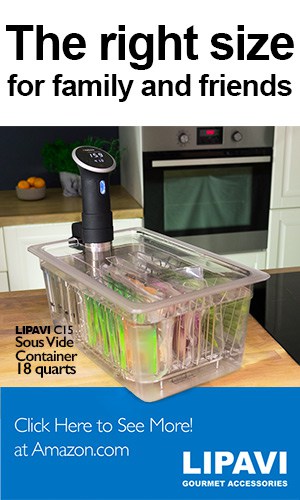-
Sous Vide Time and Temperatures
Sous Vide Time and Temps
Sous Vide Time and Temps
Sous Vide Temps
- All Sous Vide Temperatures
- Sous Vide Beef Temperatures
- Sous Vide Chicken Temperatures
- Sous Vide Duck Temperatures
- Sous Vide Fish Temperatures
- Sous Vide Vegetables Temperatures
- Sous Vide Infusions Temperatures
- Sous Vide Lamb Temperatures
- Sous Vide Pork Temperatures
- Sous Vide Shellfish Temperatures
- Sous Vide Turkey Temperatures
- Recipes Recipes Recipes Recipes
- Getting Started Guides Getting Started Guides Getting Started
- Equipment and Tools Equipment and Tools Equipment Equipment and Tools
- More Resources More Resources Resources More Resources
Sous Vide Cooking Times by Thickness and Pasteurization Charts
More Sous Vide Articles
•
Sous Vide • Sous Vide Recipes
Click here to get great sous vide content via email
Written by Jason Logsdon
There are two ways to cook sous vide, one is based on the thickness of the food and the other is based on the desired tenderness.
A thicker steak takes longer than a thin steak, so when cooking based on the thickness of the food it is helpful to have a reference guide to fall back on. I've combined several of the respectable sous vide time and temperature charts into one easy-to-use reference.
For cooking by tenderness, you can access my comprehensive sous vide temperature and time charts. It's a great temperature guide for all cuts of meat, especially the tough cuts that need longer cook times.

Learn About Cooking By Thickness from Jason
Table of Contents
- Sous Vide Heating Times for Beef, Lamb and Pork
- Sous Vide Cooling Times for Beef, Lamb and Pork
- Sous Vide Pasteurization Times for Beef, Lamb and Pork
- Sous Vide Pasteurization Times for Chicken
- Sous Vide Heating Times for Fatty Fish
- Sous Vide Cooking By Thickness
- Notes on the Sous Vide Times
Sous Vide Cooking By ThicknessTop
If this is your first time here, I highly recommend reading the description of how to use these charts.
For a printed version of these charts you can check out my high-quality Sous Vide Timing Ruler. I also offer a free, printable version of these charts if you sign up for my free Exploring Sous Vide email course. My best selling book Modernist Cooking Made Easy: Sous Vide also has these charts in it, as well as tenderness-based sous vide times for more than a hundred cuts.
Sous Vide Heating Times for Beef, Lamb and PorkTop
The Sous Vide Heating Times specify how long it takes a piece of meat, with a particular shape, to heat all the way to the center and equalize the internal temperature.
The center of the meat will come up to about 1° less than the water bath temperature in the time given. The final degree takes a much very long time and generally does not contribute to the final taste or texture of the food.

The temperature of the water bath does not really affect the heating time, but remember that you should not cook food at less than 54.5°C (130°F) for more than 4 hours. If you want to cook a piece of food at a lower temperature, you can cut it into smaller portions so it heats more quickly.
The times shown are also minimum times and food can be, and sometimes needs to be, left in for longer periods in order to fully tenderize the meat.
I provide sous vide times both for frozen and refrigerated foods, in both a cylinder and a slab. Cylinders are things like roasts, tenderloin and loin, where slabs are more like sous vide steak and sous vide pork chops.
While there are slight differences in the heating time for different temperatures of water baths, the times usually vary less than 5 to 10% even going from a 44°C bath to a 60.5°C bath, which equates to a difference of 5 minutes every hour. We show the largest value in the chart, but remember there isn't an exact single time.
These times usually apply to all types of meats except fish, though chicken and poultry are almost always cooked to pasteurization and has been left off for clarity. If you have some other type of meat (moose, bear, rabbit, etc.) you can use these heating charts as well, or the pasteurization charts below depending on whether or not unpasteurized food is safe for them.
Warning: Reminder, this food might not be pasteurized at these times and food should not be cooked at temperatures less than 55°C for more than 4 hours.
| Starting Temp: Shape of Meat: | Fridge Slab | Fridge Cylinder | Freezer Slab | Freezer Cylinder |
|---|---|---|---|---|
| 2.75" (70mm) | -- | 3:30 | -- | 5:00 |
| 2.50" (63mm) | 5:10 | 2:50 | -- | 4:20 |
| 2.25" (57mm) | 4:25 | 2:20 | 6:35 | 3:45 |
| 2.00" (51mm) | 3:35 | 2:00 | 5:30 | 3:00 |
| 1.75" (44mm) | 3:00 | 1:30 | 4:30 | 2:30 |
| 1.50" (38mm) | 2:20 | 1:10 | 3:20 | 1:50 |
| 1.25" (32mm) | 1:40 | 0:55 | 2:35 | 1:20 |
| 1.00" (25mm) | 1:15 | 0:40 | 1:50 | 1:00 |
| 0.75" (19mm) | 0:50 | 0:30 | 1:15 | 0:45 |
| 0.50" (13mm) | 0:30 | 0:15 | 0:40 | 0:25 |
| 0.25" (7mm) | 0:10 | 0:06 | 0:15 | 0:15 |
Note: For a printed version of these charts you can check out my high-quality Sous Vide Timing Ruler. I also offer a free, printable version of these charts if you sign up for my free Exploring Sous Vide email course or my free newsletter.
Sous Vide Cooling Times for Beef, Lamb and PorkTop

If you are cooking food and then storing it in the refrigerator or freezer, then these sous vide cooling times will give you the time that food needs to be in an ice bath before the center is chilled out of the danger zone. Make sure the ice bath is at least one half ice.
These times usually apply to most types of meat so if you have something unusual like moose, bear, rabbit, etc. you can use these sous vide cooling charts as a guide.
| Starting Temp: Shape of Meat: | Hot Cylinder | Hot Slab |
|---|---|---|
| 2.75" (70mm) | 2:45 | 5:30 |
| 2.50" (63mm) | 2:10 | 4:35 |
| 2.25" (57mm) | 1:50 | 4:00 |
| 2.00" (51mm) | 1:30 | 3:15 |
| 1.75" (44mm) | 1:15 | 2:45 |
| 1.50" (38mm) | 1:00 | 2:05 |
| 1.25" (32mm) | 0:45 | 1:35 |
| 1.00" (25mm) | 0:30 | 1:15 |
| 0.75" (19mm) | 0:20 | 0:50 |
| 0.50" (13mm) | 0:15 | 0:30 |
| 0.25" (7mm) | 0:10 | 0:16 |
Note: For a printed version of these charts you can check out my high-quality Sous Vide Timing Ruler. I also offer a free, printable version of these charts if you sign up for my free Exploring Sous Vide email course or my free newsletter.
Sous Vide Pasteurization Times for Beef, Lamb and PorkTop
If you want to ensure that your food is safe to eat through pasteurization, then you can follow these sous vide times. Sous vide is the most fool-proof way to ensure your food is safe to eat because you can easily monitor the core temperature.
The sous vide pasteurization chart lets you know how long you need to cook something, specifically most red meat, for it to be effectively pasteurized and safe to eat. Like the Heating and Cooling times, they are not exact, but are also on the longer side for safety reasons.
A low temperature takes longer to pasteurize that a high one. So your preferred temperature can affect how long the cooking process takes. A medium steak is safe to eat more quickly than a medium-rare steak.

These times are for meat that has been in the refrigerator, for frozen meat add some extra time.
| Thickness | 55°C (131°F) | 57°C (135°F) | 60°C (140°F) |
|---|---|---|---|
| 2.75" (70mm) | 6:30 | 5:15 | 4:00 |
| 2.50" (63mm) | 5:40 | 4:35 | 3:35 |
| 2.25" (57mm) | 5:10 | 4:00 | 3:05 |
| 2.00" (51mm) | 4:30 | 3:20 | 2:30 |
| 1.75" (44mm) | 4:00 | 3:00 | 2:15 |
| 1.50" (38mm) | 3:25 | 2:25 | 1:55 |
| 1.25" (32mm) | 3:10 | 2:05 | 1:40 |
| 1.00" (25mm) | 2:45 | 2:00 | 1:30 |
| 0.75" (19mm) | 2:30 | 1:45 | 1:15 |
| 0.50" (13mm) | 2:10 | 1:25 | 0:50 |
| 0.25" (7mm) | 1:50 | 1:00 | 0:35 |
Note: For a printed version of these charts you can check out my high-quality Sous Vide Timing Ruler. I also offer a free, printable version of these charts if you sign up for my free Exploring Sous Vide email course or my free newsletter.
Sous Vide Pasteurization Chart for ChickenTop

While there is a wide temperature range you can use, sous vide chicken is almost always cooked until it is pasteurized. The sous vide pasteurization chart below will ensure the chicken is always safe to eat.
These times are for chicken that has been in the refrigerator, for frozen chicken add some extra time.
The higher temperatures pasteurize the chicken much more quickly.
| Thickness | 58°C (137°F) | 60°C (140°F) | 63°C (145°F) | 65°C (149°F) |
|---|---|---|---|---|
| 2.75" (70mm) | 6:00 | 5:00 | 4:15 | 3:45 |
| 2.50" (63mm) | 5:20 | 4:25 | 3:35 | 3:10 |
| 2.25" (57mm) | 4:50 | 4:05 | 3:10 | 2:55 |
| 2.00" (51mm) | 4:15 | 3:20 | 2:30 | 2:20 |
| 1.75" (44mm) | 3:45 | 3:00 | 2:15 | 2:00 |
| 1.50" (38mm) | 3:10 | 2:30 | 1:55 | 1:40 |
| 1.25" (32mm) | 2:55 | 2:10 | 1:40 | 1:25 |
| 1.00" (25mm) | 2:15 | 1:35 | 1:15 | 0:55 |
| 0.75" (19mm) | 2:00 | 1:20 | 0:50 | 0:40 |
| 0.50" (13mm) | 1:50 | 1:10 | 0:35 | 0:25 |
| 0.25" (7mm) | 1:35 | 0:45 | 0:20 | 0:15 |
Note: For a printed version of these charts you can check out my high-quality Sous Vide Timing Ruler. I also offer a free, printable version of these charts if you sign up for my free Exploring Sous Vide email course or my free newsletter.
Sous Vide Heating Times for Fatty FishTop

These sous vide times will help you determine how long you need to cook fatty fish in order for it to be brought up to temperature. It will not pasteurize the fish, so make sure you use high quality fish you would be comfortable eating raw.
There are slight differences in the heating time for different temperatures of water baths but they usually vary less than 5 to 10% even going from a 44°C bath to a 60.5°C bath, which equates to a difference of 5 minutes every hour. I show the largest value in the chart.
Warning: Reminder, this food might not be pasteurized at these times and food should not be cooked at temperatures less than 55°C for more than 4 hours.
| Starting Temp: Shape of Meat: | Fridge Slab |
|---|---|
| 2.75" (70mm) | 3:50 |
| 2.50" (63mm) | 3:05 |
| 2.25" (57mm) | 2:40 |
| 2.00" (51mm) | 2:00 |
| 1.75" (44mm) | 1:40 |
| 1.50" (38mm) | 1:20 |
| 1.25" (32mm) | 0:55 |
| 1.00" (25mm) | 0:35 |
| 0.75" (19mm) | 0:21 |
| 0.50" (13mm) | 0:10 |
| 0.25" (7mm) | 0:08 |
Note: For a printed version of these charts you can check out my high-quality Sous Vide Timing Ruler. I also offer a free, printable version of these charts if you sign up for my free Exploring Sous Vide email course or my free newsletter.
Sous Vide Cooking By ThicknessTop
Cooking based on thickness is how PolyScience, Douglas Baldwin, and Nathan started out as they did research on food safety. Cooking sous vide based on thickness basically tells you the minimum time you can cook a piece of meat to ensure it is safe and comes up to temperature in the middle.
It doesn't take into account tenderizing time or any other factors. It's often used by restaurants or home cooks who want to minimize cooking time and are using tender cuts of meat that don't need the tenderization.
These are recommended cooking times, but you can go longer if desired with minimal loss in quality. The temp recommendations are highly dependant on your own preferences, and for pastuerization the times vary depending on the corresponding target temperature.

Cooking sous vide based on tenderness takes into account how tough a piece of meat is and how long it needs to be cooked in order to make it appealing. So a chuck steak needs to be cooked a lot longer than a filet, even though they are both safe after the same amount of time. As long as the minimum cooking time is met for the temperature used, then it's completely safe to eat.
Both sous vide methods have their uses. Thickness-based is great for very tender cuts cooked by people who need them done in the minimum amount of time. Tenderness-based is best for tougher cuts or people that have a range of time that they are interested in.
For a printed version of these charts you can check out my high-quality Sous Vide Timing Ruler. I also offer a free, printable version of these charts if you sign up for my free Exploring Sous Vide email course or my free newsletter. My best selling book Modernist Cooking Made Easy: Sous Vide also has these charts in it, as well as tenderness-based sous vide times for more than a hundred cuts. There are also tenderness-based cooking charts in my sous vide app for iPhone.
With the sous vide technique the method of sealing doesn't affect the minimum cook time because the plastic bag is so thin. This hold true whether you are using a vacuum sealer or Ziploc Bags and the water displacement method.
Notes on Sous Vide Times Top

Times were extrapolated from the descriptions in Baldwin's Practical Guide to Sous Vide as well as Nathan's tables on eGullet and a few other sources.
These rulers will let you know how long it takes to heat up, cool down, or pasteurize various pieces of meat. The times are to be used as a guide and are not exact because different pieces of meat heat differently, even if they are the same cut, which can affect the amount of time it takes to heat or pasteurize them. I've tried to list times at the upper edge of the range so that following them will always result in success, though they might actually be heated or pasteurized before the time listed.
Many doctors suggest that people with a weak immune system, such as elderly, pregnant or sick people should not eat un-pasteurized food, which is easily corrected using the sous vide method, especially compared to trying to hit the right temperature with traditional methods.
The times are also approximate since there are many factors that go into how quickly food is heated. The density of the food matters a lot, which is one reason beef heats differently than chicken. To a lesser degree where you get your beef from will also affect the cooking time, and whether the beef was factory raised, farm raised, or grass-fed. Because of this, I normally don't remove it from the bath at the exact minute it is done unless I'm in a real rush.
The times shown are also minimum cooking times and food can be, and sometimes needs to be, left in for longer periods in order to fully tenderize the meat. If you are cooking food longer, remember that food should not be cooked at temperatures less than 130°F (54.4°C) for more than 4 hours.
 This article is by me, Jason Logsdon. I'm an adventurous home cook and professional blogger who loves to try new things, especially when it comes to cooking. I've explored everything from sous vide and whipping siphons to pressure cookers and blow torches; created foams, gels and spheres; made barrel aged cocktails and brewed beer. I have also written 10 cookbooks on modernist cooking and sous vide and I run the AmazingFoodMadeEasy.com website.
This article is by me, Jason Logsdon. I'm an adventurous home cook and professional blogger who loves to try new things, especially when it comes to cooking. I've explored everything from sous vide and whipping siphons to pressure cookers and blow torches; created foams, gels and spheres; made barrel aged cocktails and brewed beer. I have also written 10 cookbooks on modernist cooking and sous vide and I run the AmazingFoodMadeEasy.com website.
Affiliate Disclaimer: Some links on this site might be affiliate links that if used to purchased products I might receive money. I like money but I will not endorse something I don't believe in. Please feel free to directly go to any products I link to and bypass the referral link if you feel uncomfortable with me receiving funds.













